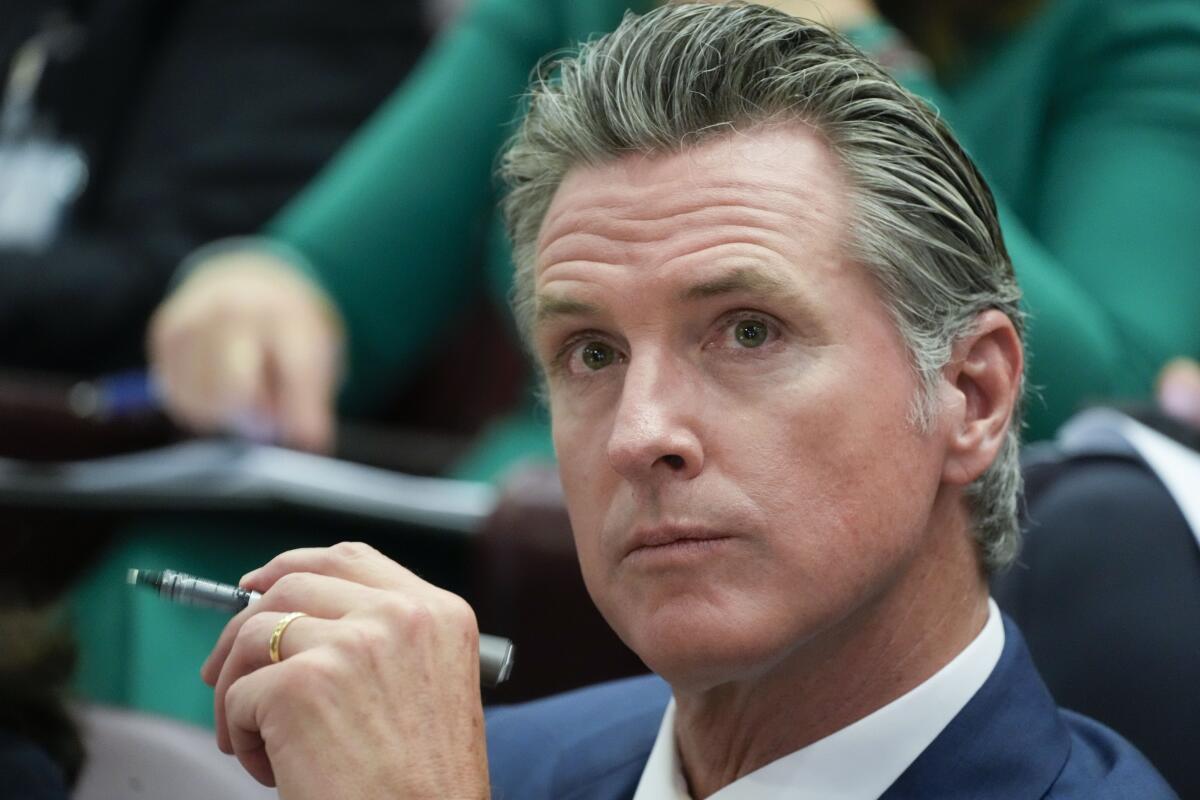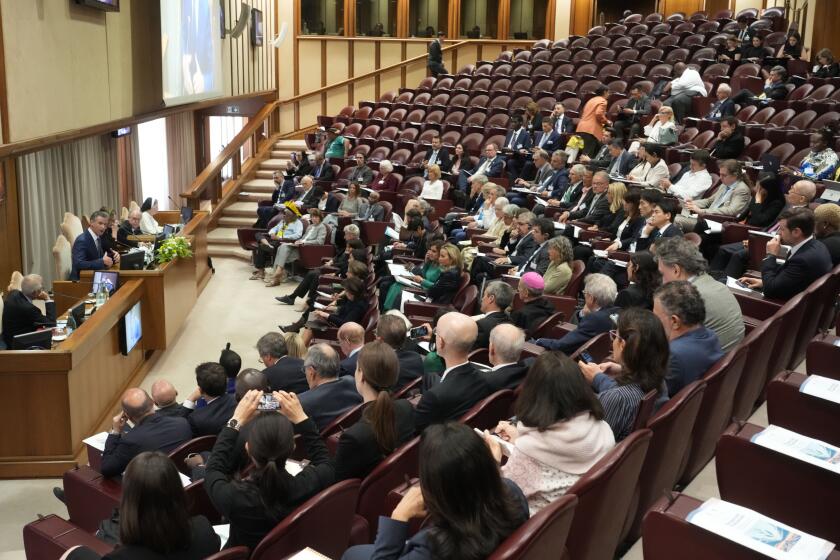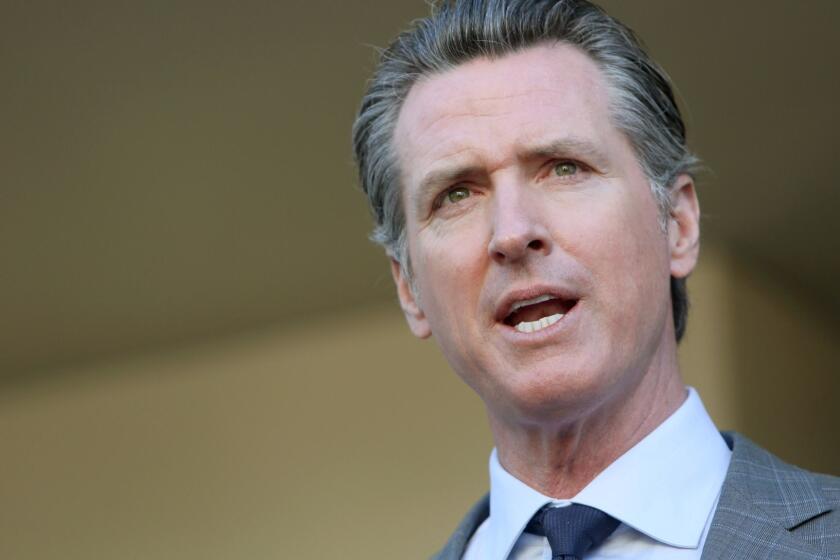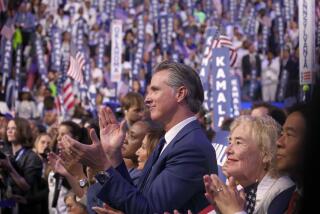Newsom leaves the Vatican with pope’s praise for refusing to impose the death penalty

- Share via
VATICAN CITY — In an opulent hall in the Apostolic Palace framed in marble and adorned with Renaissance murals, Gov. Gavin Newsom waited in a line of governors, mayors and scientists for an opportunity to greet Pope Francis.
The queue wasn’t the ideal setup envisioned by the governor’s advisors. Newsom traveled more than 6,000 miles from California to the Vatican to give a speech before — and hopefully talk with — the pope about climate change.
Pope Francis, however, had other topics on his mind besides the warming planet.
“I was struck by how he immediately brought up the issue of the death penalty and how proud he was of the work we’re doing in California,” Newsom said afterward. “I was struck by that because I wasn’t anticipating that, especially in the context of this convening.”
The talk was brief and informal. But the politically astute head of the Roman Catholic Church still took advantage of the moment to support one of Newsom’s most controversial actions as governor.
Through executive order two months after his inauguration, Newsom issued a temporary moratorium on the death penalty and ordered the dismantling of the state’s execution chambers at San Quentin State Prison. Families of murder victims criticized the decision, and legal scholars called it an abuse of power.
Newsom’s refusal to impose the death penalty could hurt him politically if he runs for president.
As a Catholic, however, the governor’s decree is in line with the church and the pope’s teachings.
In an interview with The Times after he left the Vatican, Newsom said he has yet to propose a statewide ballot measure to abolish the death penalty because he doesn’t have confidence that it would pass. California voters rejected measures to ban executions in 2012 and 2016.
Gavin Newsom, during his speech at the Vatican on climate change, accuses Trump of ‘open corruption’
Gov. Gavin Newsom called out former President Trump’s efforts to roll back climate change policies on a world stage during a climate summit at the Vatican.
Newsom said recent polls conducted by his political advisors show soft support for a ban.
“We constantly put it in our surveys that I do,” Newsom said in an interview with The Times. “It’s in the margin. But I’m thinking a lot about this beyond that because we’re reimagining death row. I’m thinking about when I’m leaving; I mean, I’ve been pretty honest about that. I’m trying to figure out what more can I do in this space.”
There were more than 730 inmates on death row when Newsom took office. Death row at San Quentin was the largest of any prison in the Western Hemisphere. Under his plan to reform the prison to emphasize rehabilitation, Newsom said California is just weeks from emptying death row entirely.
The governor said he was outspoken about his opposition to capital punishment when he campaigned in 2018. He endorsed the 2012 and 2016 ballot measures to abolish the death penalty.
“I campaigned very openly as lieutenant governor, as governor. I went out of my way to say, ‘If you elect me, this is what I’m going to do,’” Newsom said. “And also I have the legal authority. So I wasn’t challenging that.”
Currently, 21 of the 50 states impose the death penalty. The remaining 29 either have no death penalty or paused executions due to executive action — including California, according to the Death Penalty Information Center.
Newsom’s moratorium might not play well with voters in some swing states in a potential presidential campaign, adding to perceptions that leftist California and the Democratic governor are soft on crime and misaligned with the rest of the nation. The governor has repeatedly dismissed speculation that he’s eyeing the White House, and he has actively campaigned for President Biden’s reelection.
Kevin Eckery, a political consultant who has worked with the Catholic Church in California, said the death penalty isn’t going to be a deciding factor in an election.
“Nationally, the death penalty has been carried out so infrequently for the last 50 years that I don’t see people voting based on your position on [the] death penalty,” Eckery said. “They are going to vote on pocketbook issues. They are going to vote on other things, but not that issue.”
The Catholic Church has long said the death penalty could be justified only in rare situations. Francis updated church doctrine in 2018 to say “the death penalty is inadmissible because it is an attack on the inviolability and dignity of the person.”
Newsom lunched in an arched courtyard covered in jasmine at the American Academy in Rome after he, in a speech at the Vatican, accused former President Trump of “open corruption” by soliciting campaign donations from oil executives.
Sitting in a weathered wood chair under the shade of a tree, the governor explained how his Catholic background and the inequities in the criminal justice system influenced his refusal to sign off on executions as governor.
His paternal grandparents were devout Catholics, and his late father, William Newsom, who served as a state appellate court justice, went to church every day growing up, he said.
Later in life, Newsom’s father considered himself “a Catholic of the distance,” the governor said, and “kind of pushed away” because of the politics of the church.
Newsom said Jesuit teachings at Santa Clara University, where he attended college, spoke a language he appreciated “of faith and works.” His own religious beliefs, he said, have always been exercised “around a civic frame.”
“The Bible teaches many parts, one body,” Newsom said, mentioning a quote he often references. “One part suffers, we all suffer, and this notion of communitarianism.
“You can’t get out of Santa Clara University without the requisite studies and sort of a religious baseline: God and common thought type frames,” he said.
As a Catholic and San Francisco native, Newsom said his beliefs follow “the Spirit of St. Francis” and the idea of being good to others, but not necessarily a strict religious doctrine.
The governor said he attended the private Catholic school École Notre Dame des Victoires in San Francisco for a short time during early elementary school. He said his family often attended Glide Memorial, a nondenominational church in San Francisco. The governor said he attended church on Easter with his family.
Newsom mentioned religion at other points during his trip, telling reporters outside the hall where he spoke at the Vatican about the importance of the bridge between science and the pope’s moral authority on climate change.
“As we know from church, it’s faith and works,” Newsom said. “So, as we pray, we move our feet. It’s that action with our passion.”
Daniel Philpott, a professor of political science at the University of Notre Dame, said it’s smart for politicians in either party to talk about faith.
“We’ve learned over the last 30 years that presidential candidates in general benefit when they can be shown to be religious, or practicing their religious faith,” Philpott said.
Newsom said he didn’t want to overplay the influence of religion on his position on the death penalty, which his father also opposed.
His father and grandfather were involved in the case of Pete Pianezzi, a friend who was wrongfully convicted of first-degree murder in the shooting and killing a gambler and busboy in Los Angeles in 1937.
Pianezzi escaped the death penalty by a single vote and served 13 years in prison. He was later exonerated.
Even if it were possible to limit inequity and wrongful convictions in the criminal justice system, Newsom said he would still be against the death penalty.
Receiving the pope’s support made Newsom reflect on the way he agonized over the decision before he issued the moratorium a few years ago, he said. The governor met with families of victims and sought guidance from others prior to his announcement.
“It just never made sense to me, the basic paradigm, that we were going to kill people to communicate to the general public that killing is wrong,” he said. “I could never understand that. I could never sanction that.”
More to Read
Sign up for Essential California
The most important California stories and recommendations in your inbox every morning.
You may occasionally receive promotional content from the Los Angeles Times.












